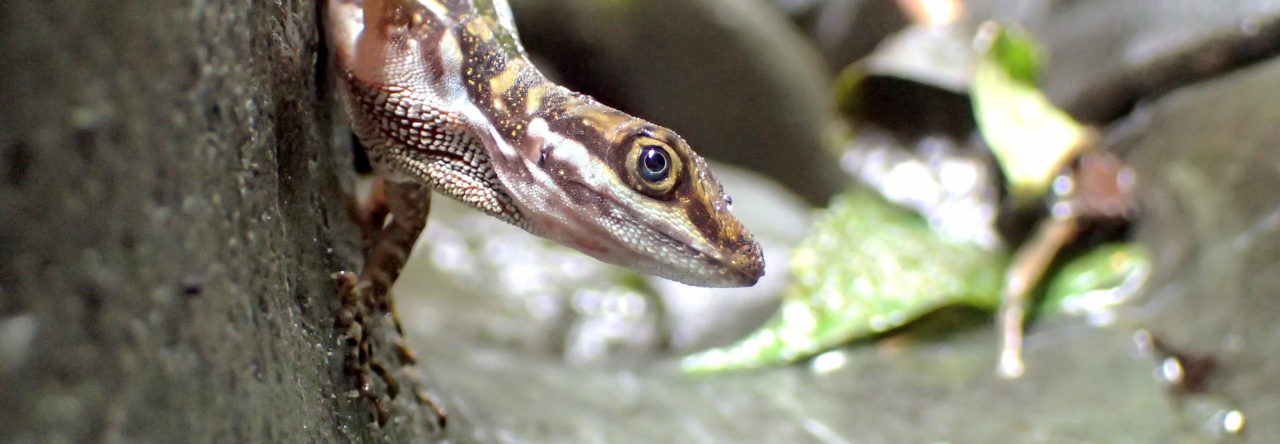We’ve had previous posts on the penchant of anoles to hitch a ride on a windshield, but this one’s the topper.
Author: Jonathan Losos Page 26 of 131
Professor of Biology and Director of the Living Earth Collaborative at Washington University in Saint Louis. I've spent my entire professional career studying anoles and have discovered that the more I learn about anoles, the more I realize I don't know.
The truth must be told.
Previous work by Anthony Russell has demonstrated that geckos have a sophisticated vascular system and connective tissues that allows the toepad of geckos to be molded to the surface with great precision, enhancing the contact between the setal hairs on the pad and the surface. It had been speculated that a similar system existed in anoles, but no one had looked carefully. Now, Russell has, and he reports in Acta Zoologica that previous statements were mistaken: anoles lack what most pad-bearing geckos have. Here’s what the abstract says:
Adhesive toe pads of geckos house modified components of vascular and/or connective tissues that promote conformity of the setal fields with the locomotor substratum. Similar modifications have been claimed for the digits of Anolis, but evidence for them is not compelling. Angiographic and histological investigations of Anolis failed to identify any evidence of either an intralamellar vascular reticular network or a central sinus. Instead, their vascularity more closely resembles that of lizards in general than that of pad-bearing geckos. The loose connective tissue of the toe pads likely contributes to their general pliability and flexibility, promoting localized compliance with the substratum. Through the shedding cycle, the lamellae change shape as the replacing setae elongate. The outer epidermal generation lacunar cells on the inner lamellar faces simultaneously hypertrophy, providing for compatibility between overlapping lamellae, enabling reciprocity between them. This contributes to continuing compliance of the setal fields with the substratum. Overall, digital structure and attachment and release kinematics of the toe pads of Anolis are very similar to those of geckos exhibiting an incipient adhesive mechanism. Both lack major anatomical specializations for promoting conformity of the setae with the locomotor substratum beyond those of the seta-bearing portions of the epidermis.
Buy ’em here, use this code: ZCUSTOMGIFTS

Karen Cusick, proprietor of Daffodil’s Photo Blog, watched this green anole turn from green to brown. Or mostly brown. I’ve seen this sometimes myself. Anyone know what’s going on here? Seen it in other green anoles?

A newborn anole arrives in November. Photo by Karen Cusick
Who says global warming is such a bad thing? Ok, it is, but at least there are some benefits, especially if you’re a brown anole in Florida. Read all about it in Daffodil’s Photo Blog.
The American Museum of Natural History just opened an exhibit on anoles that also presents information on the natural history and culture of Cuba. Or maybe it’s the other way around. But either way, you have to love their logo. The New York Times just reviewed the exhibit, and not surprisingly, anoles were a centerpiece of the article.
And here’s some text from the article:
From the recent ISBE Newsletter (28:2, p.26).
The artist, Ken Otter, who when not drawing is a professor at the University of Northern British Columbia, explains the back-story:
My first love was reptiles – birds came as a later incarnation (although I console myself that they are simply feathered reptiles). I was actually planning on shifting to working on anoles during my postdoc. I have had numerous ones as pets over the years – my students gave me a brown anole that became our lab mascot for about 5 years. I even had an undergrad student at the University of Nottingham that I was co-supervising with Pete McGregor run trials to see if males eavesdrop on dewlap displays of other males. Unfortunately, the student was primarily focused on nature photography, and we had a miscommunication on scientific design. I found out after the fact that he hadn’t quite followed protocol, so we couldn’t count all our trials, so the results were only ever presented in a conference poster and not published. He ended up as a photographer for BBC Wildlife though!
I had actually been awarded a short-term postdoc back in the 90s from the Association for the Study of Animal Behaviour to test anole signalling behaviour using video playback systems (very similar to the stuff that has since been done using Robo-lizards). Unfortunately, it came at the same time as I was offered a tenure track job here, and the University had a ‘northern research focus’ so wasn’t too keen on me heading off to the Caribbean to do field work. Guess now that I have full professorship I could always tell them to stuff themselves, but I have my research program set up now! Still find dewlap displaying fascinating, especially with the added component of UV signalling in the mix. That aspect parallels a lot of the stuff with bird signalling. The fact that males are in such close proximity and can see at least silhouettes of others displaying give a certain network component that Pete and I were always interested in pursuing, but just never go around to it. Still occupies my thoughts (hence the cartoons) and talk about it in my lectures, but guess I will have to wait to put it into field practice! Still, next North American Ornithological Congress in 2020 is being held in Puerto Rico….
And here’s another of his drawings:
Earlier this year, we reported that researchers had split the four species of green anoles on Hispaniolia, describing 12 new species. Wasting no time–and with much beauty–the Dominican Republic has placed four of these new species on stamps! Thanks to the world’s authority on anoles on stamps, Uwe Bartelt, for bringing this to our attention.









